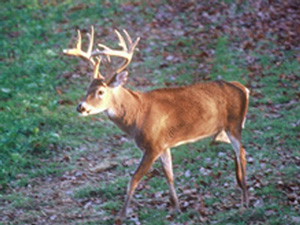
 With the rut now finished or winding down, bucks in many areas are in precarious shape. They may have lost up to 20 percent or more of their body weight from fighting, chasing does and eating only sporadically. Survival demands that they replenish their lean, worn down bodies.
With the rut now finished or winding down, bucks in many areas are in precarious shape. They may have lost up to 20 percent or more of their body weight from fighting, chasing does and eating only sporadically. Survival demands that they replenish their lean, worn down bodies.
For young, uneducated bucks this might mean feeding in an open oak flat or a farmer's field with leftover crops. If the buck is older, though, and wiser, say a 4- or 5-year-old, he will be looking for his late season food in more secluded, overlooked spots near heavy cover. He hasn't gotten that old by feeding in open fields during hunting season.
That's why I like to look for hidden pockets of soft mast that might attract a skittish, mature buck in January. Persimmons, wild pears, apples, crabapples and pawpaws that remain in trees or on the ground not only provide calories, their sugar content yields a burst of energy just like we get from a candy bar-something a buck sorely needs after the stresses his body has gone through.
If calories and energy weren't enough attractions, bucks also seem to enjoy the taste of these foods, especially when they are les plentiful late in the season. Lots of the fruits, of course, fall off trees and are eaten in fall, but often there are anywhere from a handful of scattered fruits to several hundred still clinging to individual trees as winter sets in.
Persimmons, in particular, mature and cling to branches late in the year. Often they don't become totally bright orange and sweet-tasting until October or November. I've watched bucks visit persimmon trees in my yard in January often, searching for the final few fruits that fall each day. Find spots like this and you may have located the ticket to a late season buck.
Of course finding such soft mast trees with fruits remaining isn't easy. That's why they are neglected by most hunters and you should take the effort to locate them.
For starters, forget searching in heavily forested habitat. Also ignore clean, large-scale agricultural operations with no overgrown borders or brushy areas where saplings, shrubs and wild fruit trees would be allowed to grow.
Look instead for "in between" habitat-not too open, not too heavily wooded. Look for areas that used to be farmed, maybe a few years back, maybe decades ago. Search for broken fields and overgrown meadows, areas where sunlight gets in and allows soft mast trees to thrive.
Seek out areas with rough terrain. Find habitat that's too rough, hilly or broken with cedars and brush to be worth a farmer's effort to clear it. Those are the spots where you'll find either a single soft mast tree or maybe a whole hillside scattered with them.
Mail carriers, wardens, agricultural extension agents and wildlife biologists may be able to help you find these spots. Also look on an aerial photograph or topographic map for the types locations where a bit of follow-up footwork might turn up a soft mast smorgasbord.
Once you find an area with mast that secluded from roads and parking areas, several hunting tactics can work. Stand hunting is my first choice.
Try to determine from the tracks and trails which way deer approach from, so you can sneak in without disturbing them or leaving scent on their trails. Check the prevailing winds then set up downwind a comfortable shooting distance.
A buck might visit these sites any time, but just before dark is the most likely time late in the season. One time when early morning is particularly good is just after a cold front passes through and strong winds blow the fruits off.
The second strategy I use is the sneak approach. Slip up on these areas and glass them from a distance to see if a good buck is in the area. Stay back as far as you can while still remaining hidden in cover. If you spot a deer that interests you, plan your stalk so you remain shielded by hills, ditches or vegetation work into the wind until you're in good shooting range.
I particularly like to turn to this tactic if it's a bitter cold day. That way I can ward off the chill by walking briskly between the areas with soft mast trees and then slowly sneak into range on the final approach for bucks I catch snacking on the last few frigid fruits of winter.
- 2829 views

